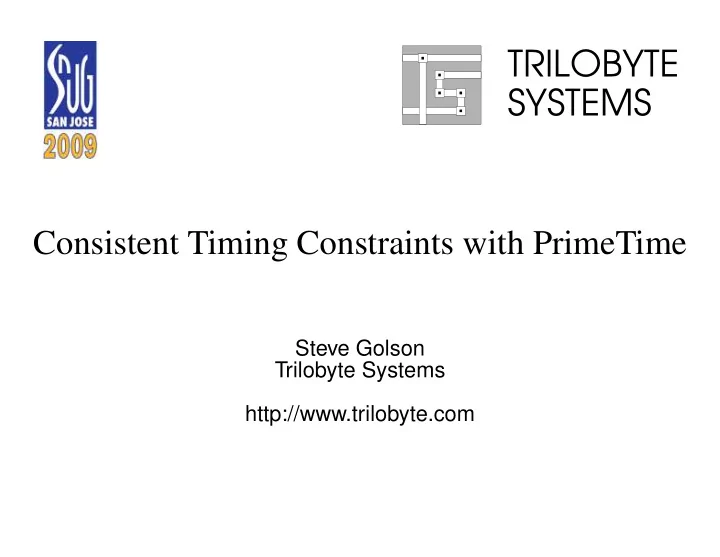

TRILOBYTE SYSTEMS Consistent Timing Constraints with PrimeTime Steve Golson Trilobyte Systems http://www.trilobyte.com
2 Physical implementation Rule #1 Do not change the functionality Rule #2 Meet the specified timing constraints
3 Physical Implementation Tools automatic test pattern generation (ATPG) cell placement clock tree synthesis (CTS) design-for-manufacturing/design-for-yield (DFM/DFY) tools detail router floorplanning
4 Physical Implementation Tools gate-level power analysis global router RTL power analysis scan insertion static timing analysis synthesis from RTL to gate-level netlist voltage drop analysis
5 Timing-driven Physical Implementation Tools Q: What do all these timing-driven tools have in common? A: They require correct and complete timing constraints Correct: constraints agree with the chip spec Complete: all paths are constrained
6 What’s the big deal? Just write “the SDC file” and use it for every tool
7 Why tools require different files • File formats • Versions • Netlist status • Features
8 Flow
9 Problems Problem #1 How to manage this multiplicity of files Problem #2 How to ensure consistency across tools
10 Consistency Timing-driven tools have consistent timing constraints if, given the same netlist, they identify the same critical path for a given path group.
11 Consistency 1. For tool A, for each path group, report the critical path. 2. In tool B, report the identical path (startpoint, endpoint, through points, clocks). 3. Tool B path must report same constraints (e.g., launch clock time, capture clock time, clock latencies, input/output delay). 4. Tool B must report the same slack.
12 Consistency 1. For tool A, for each path group, report the critical path. 2. In tool B, report the identical path (startpoint, endpoint, through points, clocks). 3. Tool B path must report same constraints (e.g., launch clock time, capture clock time, clock latencies, input/output delay). 4. Tool B must report the same slack, within some reasonable margin.
13 Solution #2: Use PrimeTime throughout the flow Switches to add to “signoff” PrimeTime scripts: • High-fanout nets? (yes or no) • Back-annotated parasitics? (yes or no) • Propagate clocks? (yes or no) • Crosstalk analysis? (yes or no) • Netlist status (for example, scan inserted or not)
14 Flow
15 Solution #1: Use PrimeTime to generate all needed files • write_sdc • write_sdc and post-process the SDC (Perl script) • custom PrimeTime Tcl to generate needed files
16 Flow
17 Flow
18 Flow
19 Problem: SDC command interpretation SDC specification defines syntax , not behavior If the SDC says set_multicycle_path 2 -from [get_clocks clkA] set_multicycle_path 3 -from [get_clocks clkA] \ -to [get_clocks clkB] set_multicycle_path 4 -to [get_clocks clkB] What is the multicycle value for a path from clkA to clkB?
20 Problem: Hierarchy and budgeting • Maintain consistent constraints across hierarchy • Block-level constraints must be automatically generated from full-chip constraints • Min delays (hold) are as important as max delays • Use default budgets, or simple slack allocation • Accurate clock latencies are critical • This is really hard
21 Problem: Hierarchy and promotion • Block-level constraints must be promoted to full-chip example: IP block with supplied block-level path exceptions • Must automate this process • “Identical” blocks may have different constraints example: multiple copies of CPU, or IO interface perhaps different modes, with different path exceptions perhaps operating at different voltages
22 Example: extract clock latencies Given a netlist with propagated clocks, how to describe the equivalent ideal clock timing? What we want is a Tcl file that looks like this: ########## cpuA_clk set clock_source_latency(cpuA_clk:SLOW:early:rise) 1.987 set clock_source_latency(cpuA_clk:SLOW:late:rise) 2.305 set clock_source_latency(cpuA_clk:SLOW:early:fall) 1.959 set clock_source_latency(cpuA_clk:SLOW:late:fall) 2.272 set clock_network_latency(cpuA_clk:SLOW:early:rise) 1.228 set clock_network_latency(cpuA_clk:SLOW:late:rise) 1.405 set clock_network_latency(cpuA_clk:SLOW:early:fall) 1.257 set clock_network_latency(cpuA_clk:SLOW:late:fall) 1.438 set clock_global_skew(cpuA_clk:SLOW) 0.187 Then source this into Design Compiler, PrimeTime…
23 PrimeTime Tcl script to extract clock latencies foreach clock that is propagated and has a defined source get source latency attributes print source latency values foreach register using this clock find the max delay critical path to this capture register get capture clock latency => total early latency network early latency = total early – source find the min delay critical path to this capture register get the capture clock latency => total late latency network late latency = total late – source simple statistics on all network latency values print network latency values print global skew
24 Summary Our goals: • A methodology/flow which is automated flexible consistent • Repeatable, reliable results from our tools • Manually edit and maintain constraints in one place: full-chip PrimeTime Tcl scripts • Methodology which is not design-specific
25 Thank you • Mark Sprague, AMD • Jerry Frenkil, Sequence Design • Many previous clients for examples, good and bad…
26 Questions?
Recommend
More recommend